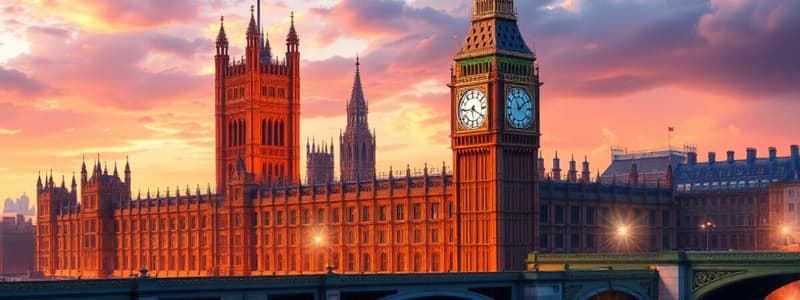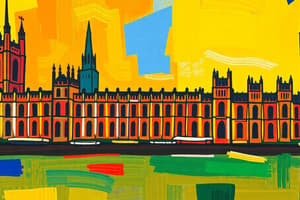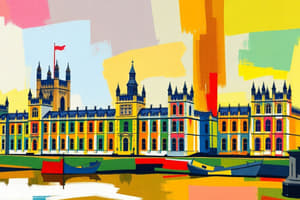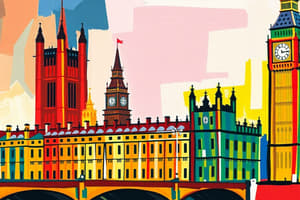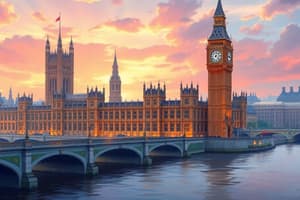Podcast
Questions and Answers
What is the common name for the Palace of Westminster, referencing its two chambers?
What is the common name for the Palace of Westminster, referencing its two chambers?
- Windsor Castle
- Whitehall Palace
- Houses of Parliament (correct)
- Buckingham Palace
Big Ben is the nickname of which tower in the Palace of Westminster?
Big Ben is the nickname of which tower in the Palace of Westminster?
- Central Tower
- Speaker's Tower
- Elizabeth Tower (correct)
- Victoria Tower
Until what year was the Palace of Westminster the primary residence of the Kings of England?
Until what year was the Palace of Westminster the primary residence of the Kings of England?
- 1512 (correct)
- 1834
- 1295
- 1970
In what century was Westminster Hall originally constructed?
In what century was Westminster Hall originally constructed?
What architectural style did Charles Barry choose for the rebuilt Palace of Westminster?
What architectural style did Charles Barry choose for the rebuilt Palace of Westminster?
Which material was primarily used in the rebuilt Palace of Westminster?
Which material was primarily used in the rebuilt Palace of Westminster?
In what year was the Palace of Westminster designated a Grade I listed building?
In what year was the Palace of Westminster designated a Grade I listed building?
What is the purpose of the Sovereign's Entrance at the base of the Victoria Tower?
What is the purpose of the Sovereign's Entrance at the base of the Victoria Tower?
Which room is used by the Sovereign to prepare for the State Opening of Parliament?
Which room is used by the Sovereign to prepare for the State Opening of Parliament?
What is the Central Lobby known for being in the Palace of Westminster?
What is the Central Lobby known for being in the Palace of Westminster?
Flashcards
Palace of Westminster
Palace of Westminster
Meeting place of the Parliament of the United Kingdom, located in London.
Westminster
Westminster
A metonym for the UK Parliament and the British Government.
Elizabeth Tower (Big Ben)
Elizabeth Tower (Big Ben)
The tower of the Palace of Westminster, a landmark of London.
Charles Barry
Charles Barry
Signup and view all the flashcards
Augustus Pugin
Augustus Pugin
Signup and view all the flashcards
Westminster Hall
Westminster Hall
Signup and view all the flashcards
Parliamentary Archives
Parliamentary Archives
Signup and view all the flashcards
House of Lords Chamber
House of Lords Chamber
Signup and view all the flashcards
House of Commons Chamber
House of Commons Chamber
Signup and view all the flashcards
Robing Room
Robing Room
Signup and view all the flashcards
Study Notes
Overview
- The Palace of Westminster in London is the meeting place of the Parliament of the United Kingdom.
- It is commonly called the Houses of Parliament, referring to the House of Commons and the House of Lords.
- "Westminster" is a metonym for the UK Parliament and British Government and the Westminster system of government.
- The Elizabeth Tower, nicknamed Big Ben, is a landmark of London and the UK.
- The palace has been a Grade I listed building since 1970 and a UNESCO World Heritage Site since 1987.
History
- Originally constructed in the 11th century as a royal palace.
- It served as the primary royal residence until a fire in 1512.
- The monarch moved to the Palace of Whitehall, but the remainder of the palace continued to house the Parliament of England since the 13th century.
- A larger fire in 1834 destroyed most of the palace, but Westminster Hall from the 12th century was saved and incorporated into the new building.
- Charles Barry won the competition to design a new palace and selected the Gothic Revival style.
- Construction began in 1840 and lasted 30 years, with delays, cost overruns, and the deaths of Barry and his assistant, Augustus Pugin.
- It contains chambers for the House of Commons, House of Lords, and the monarch, with a floor area of 112,476 m2 (1,210,680 sq ft).
- Extensive repairs were needed after the Second World War, including rebuilding the Commons chamber.
Early Parliamentary Use
- The Curia Regis, predecessor to Parliament, met in Westminster Hall when the king was in residence.
- The "Model Parliament," considered the first Parliament, met at the palace in 1295.
- Medieval parliaments met in various locations, but the palace became the body's permanent home.
- The palace initially lacked purpose-built chambers, using available gathering spaces.
- The Commons adapted St. Stephen's Chapel in the 16th century, and the Lords used the Painted Chamber and, from 1801, the White Chamber.
- Significant alterations from the 18th century on included new storage and committee rooms by John Vardy, completed in 1770
- A new official residence for the Speaker of the House of Commons, completed in 1795.
- Significant alterations and a new building by James Wyatt, completed in 1801.
- The last alterations were undertaken by Sir John Soane between 1824 and 1827, including new library facilities for both Houses of Parliament and new law courts for the Chancery and King's Bench.
The Fire of 1834 and Reconstruction
- On 16 October 1834, a fire broke out and destroyed both Houses of Parliament, and most of the palace complex buildings.
- The fire started in the House of Lords Chamber after an overheated stove, used to destroy the Exchequer's stockpile of tally sticks, set the room on fire.
- Westminster Hall, the Jewel Tower, and parts of St. Stephen's Chapel survived.
- William IV offered the almost-completed Buckingham Palace to Parliament, but it was deemed unsuitable.
- The Painted Chamber and White Chamber were repaired for temporary use.
- A Perpendicular Gothic Revival design by Charles Barry was chosen.
- Augustus Pugin designed details for Barry, who lacked Gothic experience.
- The Lords Chamber was completed in 1847, and the Commons Chamber in 1852.
- Most of the work was done by 1860, but construction finished a decade later.
World War II Bombing and Later Modifications
- During World War II, the palace was hit by bombs 14 times.
- On 26 September 1940, a bomb bent the statue of Richard the Lionheart's sword, symbolizing the strength of democracy.
- On 10–11 May 1941, the palace was hit at least twelve times, killing three people.
- The Commons Chamber and Westminster Hall's roof caught fire; the hall was saved, but the chamber was destroyed.
- The Lords Chamber and Clock Tower were damaged.
- The Commons Chamber was rebuilt in a simplified style by 1950.
- Parliament acquired office space in the nearby Norman Shaw Building in 1975 and Portcullis House in 2000.
Current Status and Restoration
- The palace was designated a Grade I listed building in 1970 and a World Heritage Site in 1987.
- The building is in urgent need of restoration.
- In January 2018, the House of Commons voted for both houses to vacate for a complete refurbishment, lasting at least six years and starting no sooner than 2025.
- In September 2022, the Restoration and Renewal Client Board was formed to oversee the works.
- Charles Barry's design utilized the Perpendicular Gothic style.
- Barry was aided by Gothic architect Augustus Pugin.
- Westminster Hall, built in the 11th century, was incorporated into Barry's design.
Material Decay and Restoration
- Barry and a committee selected Anston limestone from South Yorkshire and Nottinghamshire to rebuild the Palace of Westminster.
- The stone soon began to decay due to pollution and poor quality.
- In 1928, Clipsham stone from Rutland was used to replace the decayed Anston.
- The project began in the 1930s, halted by World War II, and completed in the 1950s.
- By the 1960s, pollution again took its toll.
- A stone conservation and restoration program began in 1981 and ended in 1994.
Victoria Tower
- At the base is the Sovereign's Entrance, used by the monarch for state occasions.
- The 15 m (49 ft) high archway is decorated with sculptures.
- The main body houses the Parliamentary Archives in 8.8 kilometers (5.5 mi) of steel shelves over 12 floors.
- The archives include Acts of Parliament since 1497 and manuscripts such as the Bill of Rights and King Charles I's death warrant.
- At the top is a 22 m (72 ft) flagstaff.
- The Royal Standard flies when the Sovereign is in the palace; otherwise, the Union Flag flies.
Elizabeth Tower ("Big Ben")
- Located at the north end of the palace, it is 96 metres (315 ft) tall.
- Formerly called the Clock Tower, it was renamed in 2012 for Elizabeth II's Diamond Jubilee.
- The tower houses the Great Clock, designed by Edmund Beckett Denison and built by Edward John Dent.
- The clock is accurate to within a second and has been reliable since 1859.
- Four 7-metre (23 ft) diameter dials are made of milk glass and lit from behind at night.
- The hour hand is 2.7 metres (8 ft 10 in) long, and the minute hand is 4.3 metres (14 ft).
Central Tower
- The shortest of the palace's towers at 91 metres (299 ft)).
- Octagonal Central Tower stands over the middle of the building, immediately above the Central Lobby.
- Added to the plans on the insistence of Dr. David Boswell Reid, who was in charge of the ventilation.
- To accommodate the tower Barry was forced to lower the high ceiling he had planned for the Central Lobby and reduce the height of its windows.
- The tower proved to be an opportunity to improve the palace's exterior design.
- This tower failed to fulfill its purpose, but it remains notable as "the first occasion when mechanical services had a real influence on architectural design".
Other Towers
- St Stephen's Tower is in the middle of the west front and houses the public entrance.
- Speaker's Tower and Chancellor's Tower are at the northern and southern ends of the river front.
- Speaker's Tower contains Speaker's House, the official residence of the Speaker of the Commons.
- Numerous turrets mask ventilation shafts.
Gardens
- Victoria Tower Gardens is a public park south of the palace.
- Black Rod's Garden is a private entrance.
- Old Palace Yard is paved with concrete security blocks.
- Cromwell Green, New Palace Yard, and Speaker's Green are private.
- College Green, opposite the House of Lords, is used for TV interviews.
Interior Layout
- The Palace of Westminster contains over 1,100 rooms, 100 staircases, and 4.8 kilometers (3 mi) of passageways spread over four floors.
- The ground floor has offices, dining rooms, and bars.
- The first floor has the main rooms, including debating chambers, lobbies, and libraries.
- The top two floors are used as committee rooms and offices.
- Some interiors were designed by J. G. Crace in collaboration with Pugin.
- The palace is rectangular, with its long axis parallel to the River Thames.
- The building is planned around the Central Lobby, with corridors leading to the Commons Chamber, Lords Chamber, Westminster Hall, and public entrance.
- A suite of rooms known as the Royal Apartments are at the disposal of the reigning monarch.
- There are separate entrances for the monarch, members of the House of Lords, MPs, and the public.
Key Entrances
- The Sovereign's Entrance is at the base of the Victoria Tower.
- Members of the House of Lords use the Peers' Entrance in the middle of the Old Palace Yard façade.
- Members of Parliament enter from the Members' Entrance in the south side of New Palace Yard.
- St Stephen's Entrance is the public entrance.
Sovereign's Entrance and Norman Porch
- The Sovereign's Entrance is beneath the Victoria Tower.
- It is used by the monarch and visiting dignitaries.
- A staircase leads to the principal floor with 26 grey granite steps.
- At the top is the Norman Porch, named for its proposed decorative scheme.
- The porch contains stained glass windows depicting Edward the Confessor and a young Queen Victoria, a copy of a 1900 painting of Victoria by Jean-Joseph Benjamin-Constant, and busts of prime ministers.
Robing Room
- Lies at the southern end of the palace, overlooking Victoria Tower Gardens.
- The Sovereign prepares for the State Opening of Parliament in this room.
- The focus is the chair of state under a canopy adorned with the arms and floral emblems of England, Scotland, and Ireland.
- A panel of purple forms the backdrop to the chair, embroidered by the Royal School of Needlework with the royal arms, surrounded by stars and VR monograms.
- Edward Barry designed the chair and the ornate marble fireplace.
- The decorative theme is the legend of King Arthur.
- Five frescoes by William Dyce depict allegorical scenes from the legend.
- A series of 18 bas-reliefs beneath the paintings, carved in oak by Henry Hugh Armstead, show attributes of the Knights of the Round Table.
- The frieze displays the attributed coats of arms of the Knights of the Round Table.
- The ceiling is decorated with heraldic badges.
Royal Gallery
- The Royal Gallery sits immediately north of the Robing Room
- It measures 33.5 by 13.7 metres (110 by 45 ft).
- It is the stage for the royal procession at State Openings of Parliament.
- It has been used by visiting statesmen and for receptions.
- Documents from the Parliamentary Archives are on display.
- Walls are decorated by two large paintings by Daniel Maclise: The Death of Nelson and The Meeting of Wellington and Blücher after the Battle of Waterloo.
- Eight statues of gilded Caen stone sculpted by John Birnie Philip depict monarchs during key battles or wars: Alfred the Great, William the Conqueror, Richard I, Edward III, Henry V, Elizabeth I, William III, and Anne.
- The panelled ceiling features Tudor roses and lions and stained-glass windows show the coats of arms of the Kings of England and Scotland.
Prince's Chamber
- A small anteroom between the Royal Gallery and the Lords Chamber.
- Named after the room adjoining the Parliament Chamber in the Old Palace of Westminster.
- It serves as a meeting place for members of the Lords.
- 28 oil portraits on panels depict members of the Tudor dynasty, painted by Richard Burchett and his pupils.
- 12 bronze bas-reliefs are set into the wall below the portraits, executed by William Theed in 1855–1857.
- Above the portraits are copies of six of the ten Armada tapestries.
- The room contains a statue of Queen Victoria, seated on a throne.
House of Lords Chamber
- Located in the southern part of the Palace of Westminster.
- The lavishly decorated room measures 13.7 by 24.4 metres (45 by 80 ft).
- Furnishings in the Lords' side of the palace are colored red.
- Decorated by stained glass windows and six allegorical frescoes.
- The south end has an ornate gold Canopy and Throne.
- In front of the Throne is the Woolsack, an armless red cushion stuffed with wool.
- The House's mace is placed on the back of the Woolsack.
- The Judges' Woolsack is a larger red cushion.
- Members of the House occupy red benches on three sides of the Chamber.
- The Lords Spiritual occupy the Spiritual Side and the Lords Temporal occupy the Temporal Side.
State Opening of Parliament
- Held in the Lords Chamber.
- Formally opens each annual parliamentary session.
- Every constitutional element of the government is represented.
- The Sovereign, seated on the Throne, delivers the Speech from the Throne.
- The Commons watch the proceedings from beyond the Bar of the House.
Peers' Lobby
- Lies directly north of the Lords Chamber.
- An antechamber where Lords can informally discuss or negotiate matters.
- It is a square room measuring 12 metres (39 ft) on each side and 10 metres (33 ft) in height.
- Features a floor centrepiece, a radiant Tudor rose made of Derbyshire marbles.
- The walls are faced with white stone and pierced by doorways with arms representing royal dynasties and windows stained with the arms of aristocratic families.
- Charles West Cope's eight murals depict historical scenes from the period around the English Civil War
Central Lobby
- Central Lobby is at the heart of the Palace of Westminster, directly below the Central Tower.
- It is a crossroads between the House of Lords, the House of Commons, St Stephen's Hall, and the libraries.
- The Lobby is measured at 18 metres (59 ft) across and 23 metres (75 ft) from the floor to the centre of the vaulted ceiling.
- Marked as the "political centre of the British Empire".
- Constituents may meet their Members of Parliament ("Lobbying").
- The theatre of the Speaker's Procession.
- The panels between the vault's ribs are covered with Venetian glass mosaic.
- Each wall is contained in an arch ornamented with statues of English and Scottish monarchs.
- The tympana above the doorways are adorned with mosaics representing patron saints.
- Tiled floor with Minton encaustic tiles includes a passage from Psalm 127 written in Latin.
Commons' Corridor & Lobby
- The East Corridor leads from the Central Lobby to the Lower Waiting Hall, with scenes from Tudor history.
- One of the scenes may not be historical:.
- The Plucking the Red and White Roses in the Old Temple Gardens scene was taken from Shakespeare's Henry VI, Part 1.
- Adjacent to the Central Lobby, the Commons' Corridor, mirroring its counterpart in design and décor.
- Featuring scenes from 17th-century political history, including Monk Declaring for a Free Parliament.
- The Lords and Commons Presenting the Crown to William III and Mary II in the Banqueting Hall..
- Mirroring the Lords section is another antechamber - the Members' Lobby where discussions and negotiations are held plus interviews from journalists.
- Similar peers' lobby but plainer design and slightly larger.
- Damaged in 1941 bombing and rebuilt in a simplified style.
- The Rubble Arch has been left unrepaired as a reminder of the evils of war.
- Surrounded the archway are bronze statues of Winston Churchill and David Lloyd George.
- The Lobby contains busts/statues of most 20th-century prime ministers, as well as boards for letters/telephone message.
Chamber of the House of Commons
- Located at the northern end of the Palace of Westminster; opened in 1950.
- Measures 14 by 20.7 metres (46 by 68 ft), plainer than the Lords Chamber.
- Benches and furnishings are colored green.
- Parliaments in Commonwealth nations have replicated this color scheme.
- The Speaker's Chair - a gift from Australia,
- The Table of the House - a gift from Canada where clerks sit and the Commons' ceremonial mace is placed.
- Dispatch boxes - gifts from New Zealand.
- Green benches on either side for Government members (Speaker's right).
- Opposition members (Speaker's left).
- No cross-benches as in the House of Lords.
- Relatively small, accommodating only 427 of the 650 MPs.
- Sovereign does not enter the Chamber of the House of Commons, since 1642.
- William Lenthall (Speaker) famously replied: "May it please your Majesty...".
- Red lines separated by 2.5 metres (8 ft 2 in) on the floor of the House of Commons.
- MPs may not cross these lines when speaking (historically to prevent duels).
Westminster Hall
- The oldest surviving palace building having been erected in 1097 for William II (Rufus).
- Many functions over spanning centuries.
- Was used for judicial purposes from the twelfth to the nineteenth centuries and a hosting area.
- The hall is on rare occasions the venue when a joint address is given to the two chambers of the UK Parliament.
- Coronation banquets were held here until the nineteenth century.
- Since the twentieth century has been the usual venue for the lyings in state of state and ceremonial funerals
- Notable hammerbeam roof commissioned for Richard II in 1393, built by Hugh Herland.
- It is England's largest clearspan medieval roof, measuring 20.7 by 73.2 metres (68 by 240 ft).
Other Features
- Libraries: There are two suites of libraries on the Principal Floor overlooking the river - the House of Lords Library and House of Commons Library.
- State Apartments: official residences for the presiding officers of the two Houses.
- Facilities: The Strangers' Bar and other bars, cafeterias and restaurants.
- Souvenir Shops: Parliament has a variety souvenirs for sale - House of Commons key-rings and china etc.
Security
- Black Rod oversees security for the House of Lords.
- The Serjeant at Arms does the same for the House of Commons.
- Security is the responsibility of the Parliamentary Security Director.
- Parliament has its own professional security force still dictates that only the Serjeant at Arms may enter the Commons chamber armed.
- Vehicle protection via series of placed concrete blocks.
- River exclusion zone: Extends 70 metres (77 yd) from the bank
- No Unauthorised vessels are allowed.
- The Serious Organised Crime and Police Act 2005 formerly made it illegal to hold a protest near the palace - authorization from the Metropolitan Police necessary.
- Metal detectors and scanning equipment for Visitors.
- Presence of Metropolitan Police and Diplomatic Protection Group.
Historical Incidents
- Gunpowder Plot (1605):
- Roman Catholic gentry plot to assassinate King James I and re-establish Catholicism.
- Planned to detonate gunpowder beneath the House of Lords during the State Opening.
- The cellars of the palace have been searched before every State Opening of Parliament ever since
- Execution of Sir Walter Raleigh (1618).
- Assassination of Spencer Perceval (1812):
- Shot in the lobby of the House of Commons by John Bellingham - the only British Prime Minister to have been assassinated.
- Fenian bombs (1885):
- Dynamite explosions in the New Palace destroyed the floor, damaged the roof but no injuries.
- Westminster Hall closed to visitors for several years - re-admitted in 1889 under certain restrictions.
- IRA bomb (1974):
- Planted planted 9-kilogram (20 lb) bomb in Westminster Hall.
- Explosion caused injuries and extensive damage.
- Airey Neave assassination (1979):
- Car bomb claimed the life of Airey Neave.
- Both the Irish National Liberation Army and the Provisional IRA claimed responsibility for Neave's assassination.
- Politically Motivated "Direct Action":
- Man threw tear gas into the Chamber to protest gas North Ireland (1970).
- Yana Mintoff threw bags of horse manure (1978).
- Greenpeace & Climate Change Protests
- 2017 Westminster attack
- 2019 Extinction Rebellion protest glued themselves to the handrail
Rules and Customs
- Smoking is prohibited in the House of Commons since the 17th century, and members may take snuff.
- Eating and drinking is prohibited.
- Members must wear formal attire.
- Hats and military decorations are banned. Speech reading is restricted.
- Applause is not normally permitted, but has been tolerated.
Additional Points
- Arrests can occur within the palace despite its status.
- Claude Monet painted the Palace of Westminster under various lighting conditions with smog.
- UNESCO classifies site as a World Heritage Site.
- There are tickets available for public viewing with limitations of capacity.
- Underground access: Nearest London Underground station is Westminster, on the District, Circle and Jubilee lines.
- Magna Carta and representative parliament celebrations in 2015 .
- Decorative references with Irish symbols (Irish harp, the shamrock) exist throughout the Palace of Westminster.
- Six of Henry Yevele's statues remain today.
Studying That Suits You
Use AI to generate personalized quizzes and flashcards to suit your learning preferences.
